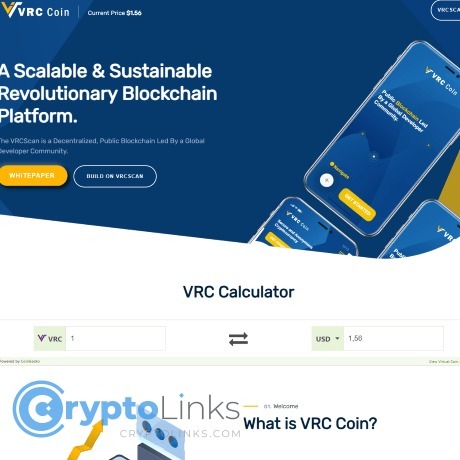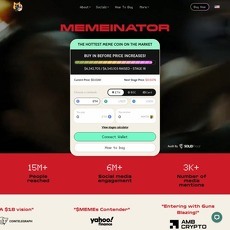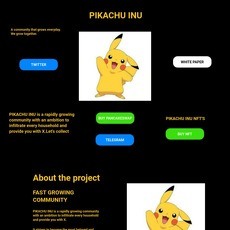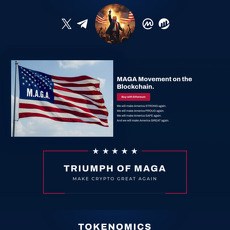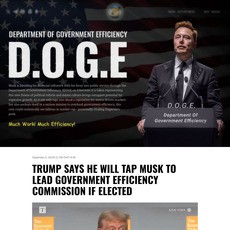VRC coin Review
VRC coin
vrccoin.com
If your website is on the scam list and you think that you are not a scammer, contact us. After you provide us with all the proof that you are in Crypto World with good intentions, we will delist you. Usually, you get in this category because you are hiding your team, you have a bad reputation(you are tricking, deceiving, scamming people), and you haven't got a written project whitepaper or is a shitty one....
Their Official site text:
A POWERFUL ECOSYSTEM OF
METAVERSE, WEB3 & DECENTRALIZED SOCIAL
MEDIA PLATFORMS.
WHITEPAPER
Powered by
ABSTRACT
INTRODUCTION & OVERVIEW
BLOCKCHAIN
WHAT IS BLOCKCHAIN
PROOF VALIDATION (NODES VALIDATIONS)
ETHEREUM VIRTUAL MACHINE (EVM)
BLOCKCHAIN PLATFORMS
1
3
4
5
7
8
5
9
13
14
SMART CONTRACTS IN BLOCKCHAIN
HIGH-PERFORMANCE SMART CONTRACTS
BLOCKCHAIN FOR DATA MANAGEMENT
GLOBAL BLOCKCHAIN MARKET
WHY VRC SCAN?
VIRTUAL COIN (VRC) EXECUTION CORE
HIGH AVAILABILITY OF JSON-RPC AND
RPC PUB/SUB APIS
FOREST OF TRIES
ˇˋ˃˂˂ʿ˲ˉʴʿʼʷʴˇʼ˂ˁ
2
17
19
21
22
24
26
28
27
29
ABSTRACT
3
This paper proposes a new blockchain architecture based on Proof of Work
(PoW). Present-day blockchain architectures all suffer from a number of issues
not least practical means of extensibility and scalability. We believe this stems
from tying two very important parts of the consensus architecture, namely
canonicality and validity, too closely together. Virtual Coin (VRC) is an
open-source public blockchain platform that supports smart contracts. Virtual
Coin (VRC) is compatible with Ethereum which means that you can migrate
smart contracts on Ethereum to Virtual Coin (VRC) directly or with minor
modifications.
While Virtual Coin (VRC) features a complete development environment for
solidity developers, Metaverse, Defi, Web3 payments, & the focus in the gaming
industry.
These rules, referred to as a consensus mechanism, are determined at the
inception of the blockchain. By integrating a consensus mechanism,
blockchains offer a solution for entities who aren't sure of each other's
trustworthiness to agree on a transaction's inclusion in the blockchain.
This tackles the Byzantine Generals Problem. Blockchains use varying consensus
mechanisms depending on their transaction type, including "proof of work",
"proof of stake", and "proof of space". These mechanisms ensure the authenticity
and immutability of transaction records.
4
INTRODUCTION & OVERVIEW
Satoshi Nakamoto's development of Bitcoin in 2009 has often been hailed as a
radical development in money and currency, being the first example of a digital
asset which simultaneously has no backing and no centralized issuer or
controller. The cryptocurrency market was evaluated at around ($1) Trillion for
2021.
Every day we interact with technologies controlled by a handful of large
companies whose interests and incentives often conflict with our own.
If we want the benefits of using their proprietary apps, we’re forced to agree to
terms that most of us will never read, granting these companies complete control
over the data we generate through each interaction with their tools.
Because that data can often paint a detailed picture of our personal lives, it’s
become a resource more valuable than oil. And we’re giving it up for free with no
choice but to trust that it won’t be lost, stolen or misused.
At the same time, progress in open-source and decentralized technologies like
blockchain has shown that we can build systems that prioritize individual
sovereignty over centralized control. With these new systems, there’s no need to
trust any third parties not to be evil.
But blockchain technology, in its current form, isn’t ready to break the corporate
stranglehold on the web just yet. Despite the promise and the progress made, we
have yet to see significant real-world deployment of the technology.
5
Block: A block acts as a unique ledger unit that records a batch of transactions
occurring within a specified timeframe. This can capture any kind of activity,
ranging from the documentation of a property sale to the record of a single
product purchase. The operational guidelines for each block are defined when
the network is initially set up, including restrictions on the maximum transaction
capacity or size of a block.
Chain: Upon reaching its maximum capacity, the block is connected to the
preceding block via a crypto-graphic link, known as a hash. This hash value of
the previous block is embedded within the new block, forging a connection
between the two. The hash function on an unchanged data block always
generates a consistent, fixed-length output. If the block's data changes, it
results in a different hash value. This allows users to identify discrepancies in
hashes and recognize any tampering with the original block.
Network: The blockchain network is a distributed system comprising nodes,
each maintaining a comprehensive record of all blockchain transactions.
There's no centralized authority or "trusted" node in the network. Rather, the
blockchain integrity is preserved through its replication across all nodes.
Nodes can be thought of as a group of servers operating a blockchain. Node
operators are rewarded for their contribution, for instance, in cryptocurrency
networks, nodes compete to solve complex computational problems. The node
that first solves the problem gets its solution validated by other nodes. Upon
verification, the solving node can add the next block to the chain and is
compensated with cryptocurrency.
BLOCKCHAIN
What is Blockchain
6
This operation is termed 'mining', and the computational resources involved
are known as 'miners'. Operating modes are challenging, often spread
worldwide, and sustain the infrastructure of cryptocurrencies. Each blockchain
operates under its unique set of rules or algorithms that dictate how nodes
verify transactions intended for the blockchain.
7
Proof of Work (PoW) is a consensus mechanism used in some blockchain
networks for validation Perform transactions and create new blocks. This
process is designed to stop cyberattacks Distributed Denial of Service (DDoS),
designed to drain system resources. It was the first The consensus mechanism
used in the blockchain, introduced by Bitcoin. The term “Proof of Work” refers to
the challenge that miners (network nodes) have to solve to suggest the next
block in the blockchain. The challenge is a complex mathematical problem,
which requires significant computational resources
PROOF OF WORK (POW)
8
Proof of Stake (POS) is a consensus algorithm used in certain blockchain
networks as an alternative to the more energy-intensive Proof of Work (PoW)
mechanism.
The fundamental goal is the same to validate transactions and achieve
agreement (or consensus) across the network but the process is quite
different. In a POS system, instead of miners competing to solve complex
mathematical problems as in POW, validators are selected to create new
blocks primarily based totally on their "stake" within side the network.
The "stake" refers to the amount of cryptocurrency a participant holds and is
willing to "lock up" or temporarily commit for the chance to validate
transactions and create new blocks.
PROOF OF STAKE (POS)
9
The more cryptocurrency a participant stake, and the longer they are willing to
leave it locked up, the higher the chance they will be selected as a validator.
When chosen, they verify the However, it additionally has its challenges.
One of the primary concerns with POS is the "Nothing at Stake" problem, where
there's no disincentive for a validator to validate on multiple blockchain forks
because they have nothing to lose by doing so. This could potentially result in
double spending.
Various iterations of PoS have been proposed to deal with these challenges,
such as Ethereum upcoming move to Ethereum 2.0, which implements a
version of PoS known as Casper
10
While "Proof Validation" or "Node Validation" isn't a consensus mechanism in
the same vein as Proof of Work or Proof of Stake, it's an important concept in
the operation of blockchain networks.
The term generally refers to the process where nodes in a blockchain network
verify, and validate new transactions and blocks. In the context of a blockchain
network, each participant or node maintains a copy of the entire blockchain.
Whenever a new transaction is proposed, it needs to be validated before being
added to the blockchain.
PROOF VALIDATION
(NODES VALIDATIONS)
This validation process involves checking the transaction against the existing
blockchain to ensure it doesn't conflict with previously recorded transactions.
For example, in the case of a cryptocurrency like Bitcoin, this validation process
would prevent someone from spending coins they don't own or duplicating
transactions (a double-spend).
11
This validation process involves checking the transaction against the existing
blockchain to ensure it doesn't conflict with previously recorded transactions.
For example, in the case of a cryptocurrency like Bitcoin, this validation process
would prevent someone from spending coins they don't own or duplicating
transactions (a double-spend).
While "Proof Validation" or "Node Validation" isn't a consensus mechanism in
the same vein as Proof of Work or Proof of Stake, it's an important concept in
the operation of blockchain networks.
The term generally refers to the process where nodes in a blockchain network
verify, and validate new transactions and blocks. In the context of a blockchain
network, each participant or node maintains a copy of the entire blockchain.
Whenever a new transaction is proposed, it needs to be validated before being
added to the blockchain.
This validation process involves checking the transaction against the existing
blockchain to ensure it doesn't conflict with previously recorded transactions.
For example, in the case of a cryptocurrency like Bitcoin, this validation process
would prevent someone from spending coins they don't own or duplicating
transactions (a double-spend).
The specific process of validation can depend on the consensus mechanism
employed by the blockchain:
1. In a Proof of Work (PoW) system, nodes (called miners) compete to solve
a complex mathematical problem. The first one to solve it gets the right
to validate the transactions, create a new block, and add it to the
blockchain.
12
2. In a Proof of Stake (PoS) system, validators are chosen to validate
transactions and create New blocks primarily based totally on their stake,
i.e. the number of tokens they hold and are willing to "lock up" or commit
for this purpose.
Once transactions are validated and added to a new block, and the block is
added to the blockchain, other nodes in the network update their copies of the
blockchain, maintaining the decentralized and synchronized nature of the
network.
By distributing the task of validation across many nodes, blockchain networks
increase their security and resilience against fraudulent transactions and other
forms of attack. It's a crucial part of what makes blockchain technology robust
and secure.
13
EVM stands for Ethereum Virtual Machine. It is an essential part of the Ethereum
ecosystem, as the runtime environment executes smart contracts on the
Ethereum network. The EVM is completely isolated from the main Ethereum
network, which makes it a perfect sandbox tool for testing smart contracts. The
EVM is Turing complete, meaning it can execute any algorithm given enough
resources.
Any programming language that compiles to EVM bytecode can be used to
write smart contracts on the Ethereum network. Solidity is the most popular of
these, though others like Viper are also used. In terms of operation, every node
on the Ethereum network runs its own EVM implementation and executes the
same instructions.
When a smart contract is executed, every node in the network must process it
and come to the same result, ensuring consensus across the network. This is
the process that uses gas, a measure of computational work in the Ethereum
network.
The EVM also handles internal state changes and allows users to create and
interact with smart contracts on the Ethereum blockchain. All transactions and
states are stored on the blockchain, providing transparency and security.
However, it's important to note that the EVM doesn't have access to real-world
information, so developers often use oracles to provide this data for smart
contracts.
ETHEREUM VIRTUAL MACHINE (EVM)
14
Blockchain is a flexible technology composed of various foundational elements
that can be assembled in diverse ways. This adaptability allows for blockchain
to be tailored to various applications.
Here's a brief review of four distinct blockchain platforms that embody different
approaches:
Bitcoin: Known for its eponymous cryptocurrency, Bitcoin operates on an
open-source platform. Its blockchain design is intended primarily to
facilitate cryptocurrency transactions without a third-celebration
mediator. Besides facilitating monetary transfers, Ripple also supports
exchanges of commodities, properties, and other valuable items.
Bitcoin operates on a zero-trust model among participants and relies on a
multitude of decentralized nodes to protect the blockchain from potential
corruption by bad actors.
BLOCKCHAIN PLATFORMS
15
Ripple:Similar to Bitcoin, Ripple employs an open-source protocol with blockchain technology for value transfers. It has a robust user base comprising
regional and global banks that require on the spot global transactions. Supports
exchanges of commodities, properties, and other valuable items.
Ethereum: Launched in July 2015, Ethereum distinguishes itself by focusing
beyond just cryptocurrency trades. Its primary aim is to offer a fully operational
programming language that enables users to build comprehensive applications
˜ˡ˧˘˚˥˔˧˘˗˪˜˧˛˔˕˟ˢ˖˞˖˛˔˜ˡʡʴ˦˔ˡˢˣ˘ˡ˦ˢ˨˥˖˘ʟ˖˥ˢ˪˗ʠ˙˨ˡ˗˘˗ˣ˟˔˧˙ˢ˥ˠʟʸ˧˛˘-
reum allows users to create executable smart contracts and decentralized
packages on its blockchain
16
Hyper ledger: This project concentrates on cultivating an open-source,
collaborative approach to distributed ledgers. By developing standards and a
structural framework for blockchain, hyper ledger has attracted the support of
renowned organizations like Cisco, American Express, and IBM. Some institutions
focusing on library and information sciences have also integrated hyper ledger
into their curriculum. Notably, hyper ledger has explicitly declared that it will not
develop a cryptocurrency
17
A smart contract represents a digitally enforced agreement that operates on
a blockchain platform. In essence, it's miles a settlement converted into code,
saved on the blockchain, and robotically induced through positive events.
Simplistically, a smart contract can be seen as a series of "if/then" conditions
programmed and preserved on the blockchain.
Upon satisfying the conditions defined in the smart contract, it self-executes,
and the subsequent activity is recorded and dispersed across the blockchain.
Consider an artist selling a digital track on an online platform at a predefined
rate. Such an agreement can be coded into a smart contract, on Ethereum.
Once a fan makes a purchase, the smart contract autonomously remits the
payment to the artist and logs the transaction on the blockchain.
SMART CONTRACTS IN BLOCKCHAIN
18
Throughout the evolution of blockchain systems, developers could script smart
contracts that render transaction data or records cryptographically obscured,
meaning that although the records are not erased from the blockchain, they
become cryptographically shielded, making them invisible to the overall
public. It remains uncertain if cryptographically hidden data can be considered
permanently inaccessible and therefore deemed "erased" from the complete
record. From a records management viewpoint, the existence of such features
as crypto graphically hidden data suggests that records retention and
disposition might not have been a primary consideration in the original
blockchain design. However, smart contracts could potentially address issues
such as record access, retention, disposition, and litigation holds, depending
on how the rules, roles, and features of the blockchain are configured and
developed.
High-Performance Smart Contracts refer to smart contracts that are designed
to optimize transaction speed, scalability, and overall performance. These
smart contracts are built to process large volumes of transactions quickly,
efficiently, and reliably.
A high-performance smart contract can be crucial for applications that
require fast and high- volume transactions. These include financial services
applications like decentralized exchanges, payment networks, or any
applications that require real-time response. Several factors contribute to the
performance of smart contracts:
Concurrency: High-Performance Smart Contracts should be able to manage
multiple transactions simultaneously. This is achieved through concurrent
execution where different transactions are processed at the same time
19
HIGH-PERFORMANCE SMART CONTRACTS
Scalability: Scalability refers to the ability to manage increased workloads by
adding resources. In the context of smart contracts, this means being able to
handle a higher number of transactions as the network grows.
Efficient Code: The efficiency of the smart contract's code also affects its
performance. Efficient code executes faster and uses less computational
resources, thereby improving the smart contract's performance.
State Channels/Off-chain computations: These techniques can be used to
move some computations off the blockchain, thereby reducing the load on the
blockchain network and improving performance.
Blockchain platforms that are specifically designed for high-performance
applications, such as Solana or EOS, provide an environment that allows for the
creation of High-Performance Smart Contracts.
They do this by utilizing various strategies like sharing, consensus algorithms
designed for speed and throughput, and other architectural decisions aimed
at high performance.
20
21
The concept of 'archived information' isn't confined to conventional records. It
spans all formats and features, including data generated, manipulated, communicated, or saved in the digital sphere.
The cryptographically secure hash, block header, and intricate web of
transactional data embedded within each block could very well be federal
records if they have been crafted in the course of government business and
are considered suitable for safekeeping.
Each block within the chain is a treasure chest, potentially filled with a myriad
of record types, each stemming from a unique transaction. The core strength
of blockchain technology lies in its decentralized nature that champions
distributed data management.
This implies that all the records find their home on the blockchain network or
platform, and are shared across all participating nodes, like sparkling
constellations in the digital universe.
BLOCKCHAIN FOR DATA MANAGEMENT
22
Embarking on an astounding growth trajectory, the global blockchain market
is poised to soar, reaching new heights and unlocking unprecedented
opportunities. In 2021, the market was valued at an impressive €5.10 ($6.0)
billion, with an awe inspiring CAGR of 56.9% forecasted from 2021 to 2026.
As the world embraces blockchain technology, the landscape of B2B cross border
transactions is undergoing a paradigm shift. The horizon of possibilities
broadens as blockchain emerges as the harbinger of a revolutionary
transformation.
With great anticipation, experts predict a dramatic surge in B2B cross-border
transactions conducted on blockchain, reshaping the future of global commerce.
The forthcoming years herald a striking revelation - by 2025, the number of B2B
cross-border transactions on the blockchain is expected to scale at unprecedented heights, reaching an astonishing 745 million.
GLOBAL BLOCKCHAIN MARKET
23
This remarkable milestone epitomizes the trust and confidence the world bestows upon blockchain, as it becomes the go-to solution for secure,
transparent, and efficient cross-border transactions.
In this dynamic and ever-evolving landscape, the global blockchain market
paves the way for innovation, collaboration, and limitless possibilities. As
enterprises, industries, and economies embrace this transformative
technology, a world of boundless potential awaits.
Unleashing the power of blockchain, we embark on an exhilarating journey,
shaping a future that thrives on security, efficiency, and borderless
opportunities
In a world where the demand for efficient and scalable blockchain solutions is
growing, Virtual (VRC) Scan emerges as a project poised to meet these
challenges head-on.
Through its commitment to innovation, security, and scalability, Virtual (VRC)
Scan aims to provide an advanced blockchain solution for the next
generation of decentralized applications.
Virtual (VRC) Scan stands out in the crowded landscape of blockchain
projects for several notable reasons:
Efficient Consensus Mechanism: By utilizing a Proof of Stake (PoS) consensus
algorithm, Virtual Coin (VRC) Scan provides a more energy-efficient alternative
to traditional Proof of Work (PoW) systems. This means the network can process
transactions and secure the blockchain with a significantly lower energy cost.
1. Enhanced Security: The PoS mechanism discourages malicious activity. For a
potential attacker to compromise the network, they would need to hold a majority
of the tokens, which would be prohibitively expensive, thereby ensuring
the security of the network.
2. Scalability: Virtual (VRC) Scan is designed with scalability in mind. The PoS
consensus algorithm allows for faster transaction processing times and
an increased transaction capacity compared to PoW- based networks.
This means that as the network grows, Virtual (VRC) Scan will be
able to efficiently handle an increased demand.
WHY VRC SCAN?
24
3. Incentivized Participation: Virtua(VRC) Scan encourages active network
participation. Users who stake their tokens to become validators are rewarded for
their service to the network, promoting a healthy and active blockchain
ecosystem.
4. Broad Application Spectrum: Virtual (VRC) Scan, thanks to its flexible
infrastructure, can cater to a wide range of applications, from financial services to
supply chain management, and more. This positions VIRTUAL COIN (VRC) Scan as
a versatile tool in the rapidly evolving landscape of decentralized technologies.
25
26
VIRTUAL COIN (VRC) EXECUTION CORE
The following diagram outlines the high-level architecture of VRC
˙ˢ˥˲ˣ˨˕˟˜˖˲ˡ˘˧˪ˢ˥˞˦
27
HIGH AVAILABILITY OF JSON-RPC
ʴˁʷ˅˃ʶ˃ˈʵʢˆˈʵ˲ʴ˃ʼˆ
To enable high availability to the RPC Pub/Sub API over WebSocket or theJSON-RPC API, run and synchronize more than one VRC node to the network. Use
a load balancer to distribute requests across nodes in the cluster that are ready
˧ˢ˥˘˖˘˜˩˘˲˥˘ˤ˨˘˦˧˦ʡ
28
FOREST OF TRIES
TX POOL VALIDATION
29

